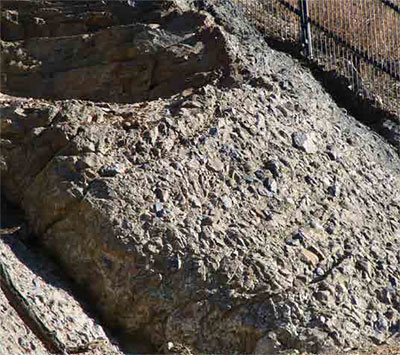Zakázanka
Menu- Welcome to Zakázanka
- In search of bygone eons
- An example of a reverse fault and a crush zone
- Folds
- A fault separating two geological periods
- Iron ore
- Exposed boundary
- What is growing here (1)
- What is growing here (2)
- Little warm lovers
- Sun lovers
- Bedrock
- Fluvial sandy gravels of the vineyard terrace
- Local denizens of the air
- A window into Prague's geological past
- Iron ore on the zoo grounds
- The rock face bears silent witness
- Regeneration of the rocky steppe
The rock face bears silent witness
As you walk along the Zakázanka Path, you will learn many interesting things; not just about animals and plants, but mainly about the geological history of the area. An important part is a feature known as a fault, which runs aslant across the rock that divides the lower and upper parts of Prague Zoo. The fault can best be appreciated from this very spot.
The beetling flat rocky ledge in the Barbary sheep enclosure is an example of a Variscan fault (which dates back to the late Paleozoic, around 350 million years ago). It was along this fault that Paleozoic rocks from the Ordovician Period (450 million years old) fastened themselves onto the Proterozoic bedrock (600 million years old). Above the fault, an Ordovician basal conglomerate and a thin layer of volcanic tuffs have survived, while below the fault, Proterozoic phyllitic wackes rise to the surface.
The angle of the fault
The angle of the fault, directed as it is under the newer strata, indicates that it is a feature known as a "normal fault"; that is, a type of fault formed when a relaxation of tension in the Earth's crust is followed by rock expansion ("extension"). The rocky overhang owes its existence to the fact that conglomerate rock is more resistant to erosion.
Basal conglomerate
A detailed view of the upper layer surface of basal conglomerate, representing a rocky ocean beach of around 470 million years ago.





